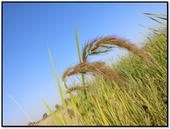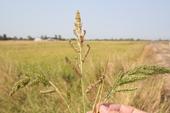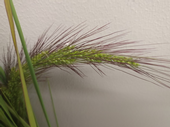- Author: Whitney Brim-DeForest

Watergrass
We are having more and more difficulties controlling watergrass over the past 20 or so years. We know that as of the early 2000s, we had found multiple-herbicide resistant late watergrass (also known as mimic), as well as multiple-herbicide resistant barnyardgrass. For early watergrass, we now have resistant biotypes (to thiobencarb), with none recorded as being multiple-herbicide resistant.
In 2017, two rice fields were identified with an unknown watergrass biotype (or species) that looked very different than the three main known species that infest California rice fields (late watergrass, early watergrass, and barnyardgrass). Both fields had...
- Author: Whitney Brim-DeForest

In 2017, I started getting reports of a watergrass biotype/species (Echinochloa spp.) that was difficult to control using our suite of herbicides registered in rice. At the time, I knew we had multiple herbicide-resistance in late watergrass (Echinochloa phyllopogon), so I initially just thought the resistant biotype was spreading, and had maybe gained resistance to additional herbicide modes of action. However, once I started visiting fields, it quickly became apparent that this was not late watergrass (phenotypically-speaking). It also did not appear to be barnyardgrass (Echinochloa crus-galli), although the Echinochloa species are notoriously difficult to identify, and phenotypically quite variable in...
- Author: Whitney Brim-DeForest
- Posted by: Gale Perez

The UCCE Rice Team is conducting a field survey to collect watergrass samples over the next few weeks. The samples will be grown out in the greenhouse to help us start figuring out the identification and phenotypic characteristics (how to distinguish one from another) for the watergrass species found in California rice fields. The hope is that this will give us data for developing chemical and non-chemical management plans for watergrass, similar to what we have been working on with weedy rice over the past few years.
The project was funded by the California Rice Research Board, and is led by Whitney Brim-DeForest (UCCE Sutter-Yuba) and
- Author: Whitney Brim-DeForest
- Re-posted by: Gale Perez

There are two (2) new posts on the UC Rice Blog written by Whitney Brim-DeForest, Cooperative Extension Rice Advisor.
- Author: Whitney Brim-DeForest

As many of you are aware, many of our grass species in California rice are resistant to multiple herbicides. Late watergrass aka "mimic" (Echinochloa phyllopogon), early watergrass (E. oryzoides) and barnyardgrass (E. crus-galli) are among some of our most competitive weed species, causing large yield reductions when uncontrolled.
One of the last remaining chemicals that our grass species are not yet resistant to is pendimethalin. Commercial formulations for pendimethalin registered for California rice are Prowl H2O and Harbinger. Prowl H2O is a delayed pre-emergent herbicide applied onto dry, drill-seeded fields. Harbinger is also a delayed pre-emergent herbicide, but the...


